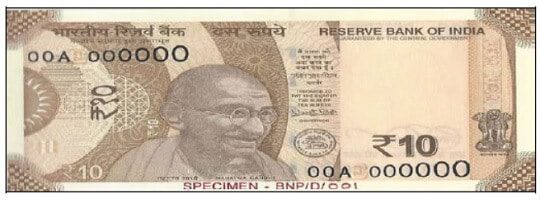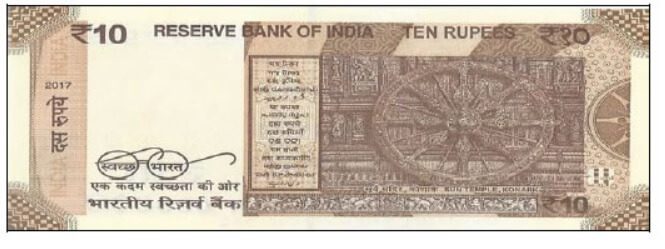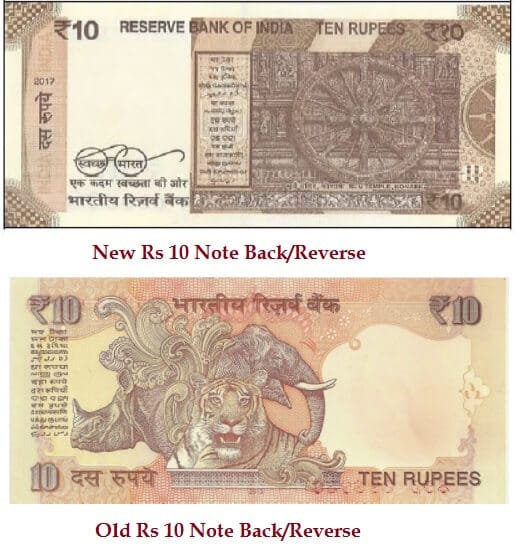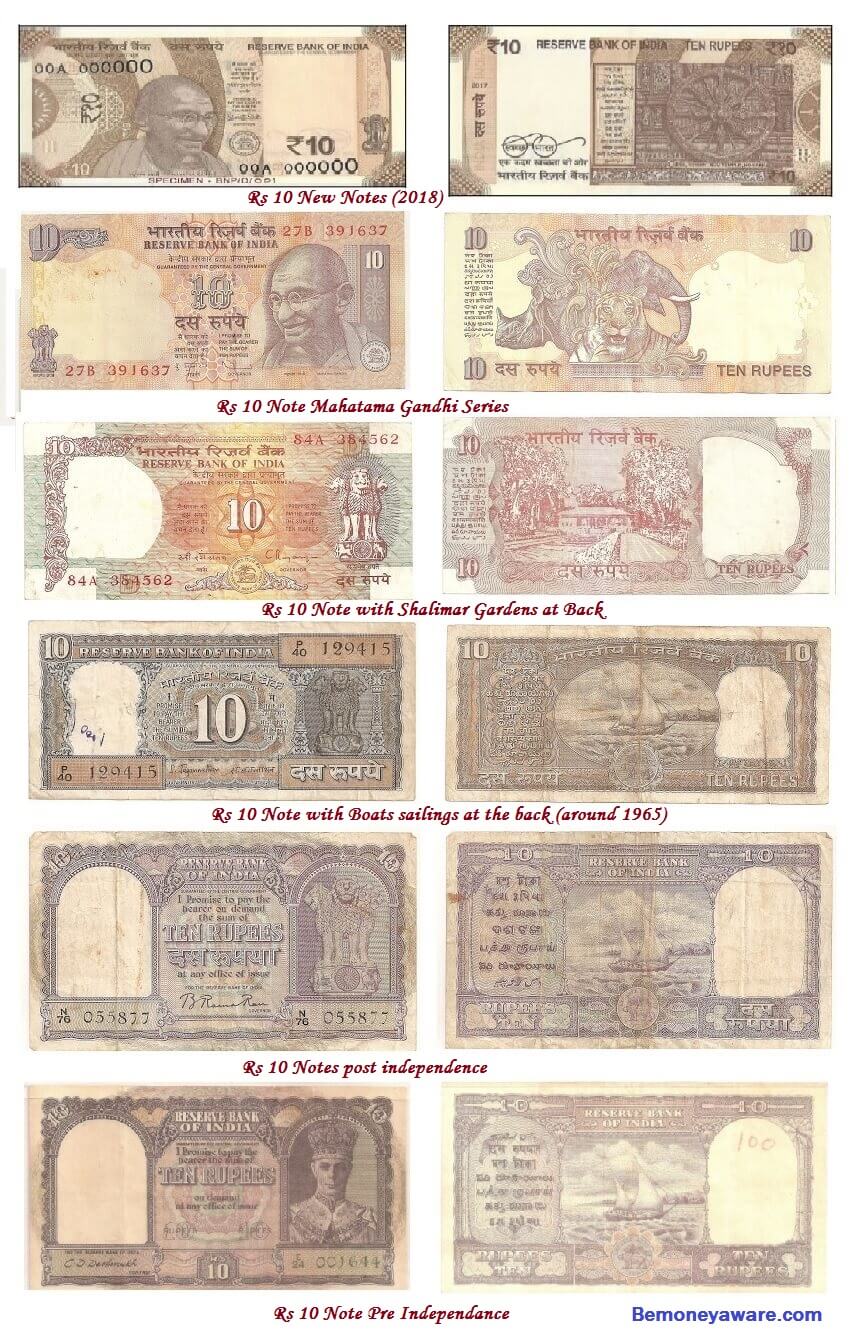The Reserve Bank of India issued new Rs 10 denomination banknotes. The new denomination has the motif of Sun Temple, Konark on the reverse The base colour of the note is Chocolate Brown. The note has other designs, geometric patterns aligning with the overall colour scheme, both at the obverse and reverse. Existing banknotes in the denomination of Rs 10 issued by the RBI in the earlier series will continue to be legal tender. This article talks about New Rs 10 Note, Compares the new 10 Rs note with existing 10 Rs note, How Rs 10 Notes have changed over time.
Since demonetization, the RBI has come out with the new design for five denominations. While the new Rs 2,000 and Rs 500 notes were introduced immediately after demonetisation, RBI had recently introduced the new Rs 200 and Rs 50 notes. Once the RBI finishes the whole exercise of putting Rs 200 notes into the system after the recalibration of ATMS, it will reportedly redesign and print the Rs 100 denomination note.
Table of Contents
Obverse or Front of New Rs 10 Notes
The dimension of the banknote will be 63 mm x 123 mm.
1. See-through register with denominational numeral 10
2. Denominational numeral १० in Devanagari,
3. Portrait of Mahatma Gandhi at the centre,
4. Micro letters ‘RBI’, ‘भारत ‘, ‘INDIA’ and ’10’,
5. Windowed demetalised security thread with inscriptions ‘भारत’ and RBI,
6. Guarantee Clause, Governor’s signature with Promise Clause and RBI emblem towards right of Mahatma Gandhi portrait,
7. Ashoka Pillar emblem on the right,
8. Mahatma Gandhi portrait and electrotype (10) watermarks,
9. Number panel with numerals growing from small to big on the top left side and bottom right side.
Reverse or Back of New Rs 10 Note
10. Year of printing of the note on the left,
11. Swachh Bharat logo with slogan,
12. Language panel,
13. Motif of Sun Temple, Konark,
14. Denominational numeral १० in Devnagari.
Comparison of old and New Rs 10 Notes
Besides the colour the new note will have the same height of 63mm as the current ten rupee note but the width will be 123mm, slightly lesser than the 137mm width of the existing note.
Another main difference is that the reverse of the note will carry a motif of the Konark Sun Temple. The existing ten rupee note carries the image of the fauna(the animals of a particular region, habitat, or geological period) of India – rhinoceros, elephant and tiger.
Different Rs 10 Notes over time
How the Rs 10 Note has changed over time is shown in the image below. The year of issue is mentioned at the back of ten rupee Notes from 2006 onwards only.
Rs 10 Note during British Time
The size of the Note was 80 x 140 mm (approx.) The front of this Note has the portrait of George VI facing front. The serial number of the Note is below the window displaying his portrait and is mentioned at one place only (unlike present-day issues). The signature of RBI Governor C.D.Deshmukh is given below the white water-mark window. Notice that the language mentioned on this side of the Note is English only. The numeral “10” figures prominently on both the top left and right-hand corners of the Note. The Governor’s undertaking “to pay the bearer the sum of TEN RUPEES on demand at any office of issue” is mentioned in five lines, below which is mentioned “10 Rupees” in two places. In 1968 the words “on demand” were removed from the RBI Governor’s promise and these words are not found on present-day issues. Various colours are found on this Note (Violet, Red, Brown, Orange and Green) along with a rudimentary security thread.
The back/reverse of the Note shows 7 Regional Languages in the Languages Panel. The main language is entirely English at the back too. The numeral “10” appears on the top left and right-hand sides. The words “Rupees ten” and “Ten Rupees” appear on the bottom left and right-hand sides respectively. A picture of a two-masted, three-sail cargo-laden boat/dhow (defined as a native Arab/Indian sailing vessel used on the Arabian Sea, generally with a mast capable of carrying 100 to 200 tons of cargo), sailing ahead, with mountains to the left and clouds above is depicted in the centre. This Note was in circulation, in Post-Independence India as well, till it ceased to be legal tender in October 1957.
Sir C.D. Deshmukh (Reserve Bank of India –RBI Governor from 11.08.1943 to 30.06.1949) was the only Governor of RBI who served during the British India Rule as well as during Post-Independence India.
Rs 10 Notes Post Independence
Post Indian Independence, the first ten rupee Independent India Note was issued under C.D.Deshmukh’s signature as well. The size of these Notes was 83 x 146 mm. A large image of the Asoka Lion Capital (the official symbol of Sovereignty of the Government of Independent India, replaced the portrait of George VI. The language on this Note was again English only, except for the Indian languages depicted on the Languages Panel at the back. Also, the sailing boat/dhow image was continued as in the earlier ten rupee notes.
Later, in August 1951, the design was altered to include Hindi on the front/face of the Note but only to mention the denomination of the Note “Dus Rupiya” (Ten Rupee). However, the Hindi translation was incorrect and was corrected in later notes issued in April 1953, to read as “Dus Rupiye” (Ten Rupees) instead of “Rupiya”.
The back/reverse of the above Note continuing with the image of the three sail sailing boat and 7 Regional Indian languages. The “Ten Rupees” in English shown on the right hand side of the Note issued during the British period, has been replaced by “ Dus Rupiya”, in Hindi (again, incorrect Spelling) which was corrected in later Notes to “Rupiye”.
Rs 10 Notes around 1965
During the tenure of RBI Governor P.C.Bhattacharya ( 01.03.1962 to 30.06.1967), a much smaller ten rupee Note, the size of this Note was 63 mm x 137 mm, was issued with an ornamental numeral “10”. The Lion capital and the white watermark window were also proportionately reduced in size. Also, the number of Regional languages at the back was raised to 13.
Another new design was introduced in 1968, during his tenure, wherein, the words “on demand” were removed from the Governor’s promise to pay a sum of ten rupees to the bearer. Also, for the first time, the Governor’s promise to pay the bearer a sum of ten rupees appeared in Hindi on the right-hand side of the prominent white numeral “10” in the middle of the front side of the Note. Another addition was that, below the “Reserve Bank of India” in English on the front side, the words “Bhartiya Reserve Bank “were mentioned in Hindi for the first time on this Note. Also, the RBI Governor’s signatures appeared in Hindi for the first time. On the back of the Note, the sailing boat design was continued.
Rs 10 Note with Shalimar Gardens at the back
A new design Note with a larger Lion Capital on the face and two peacocks, birds, lotus, deer and horse at the back was issued during 16.06.1970 to 19.05.1975
Note during S.Venkitaramanan’s tenure when the Shalimar Gardens replaced the peacocks etc.design. “Bhartiya Reserve Bank” in Hindi is placed above the “Reserve Bank of India” in English, as is the Central Government’s Guarantee. Also, the RBI Governor’s promise to pay the sum of ten rupees to the bearer is mentioned in Hindi first (on the left-hand side) and then in English (on the right hand side)
Rs 10 Notes in M.K. Gandhi Series
The large Lion Capital of Emperor Asoka / symbol of Sovereignty of the Indian Government was replaced by a portrait of M.K. Gandhi (short for Mohandas Karamchand Gandhi, or Mahatma Gandhi, the Father of the Indian Nation) on the right-hand side window. The much smaller Lion Capital moved to the bottom left-hand side of the note. His name was spelt as “Mo.Ka.Gandhi” in Hindi and “M.K.Gandhi” in English below his portrait. An ornamental numeral “10” replaced the plain white-coloured numeral “10” in the centre; a stylized white elongated D-shaped water-mark window on the left-hand side now contained a Mahatma Gandhi portrait in the watermark window, as well.
On the back of the Note, floral motifs and the figures of a Rhinoceros, Bengal Tiger and an Indian Elephant, all facing in different directions replaced the earlier design of the Shalimar Gardens. Also, the number of Regional Indian Languages on the Languages Panel on the left was raised to 15. The numeral “10” appears at three places – top left, top right and bottom left. The denomination of the note “TEN RUPEES” appears in words on the bottom right.
Rs 10 Notes in Mahatma Gandhi Series
The front of a Note issued in 2007, the name of M.K.Gandhi was changed to read as “Mahatma Gandhi” in both Hindi and English
In 2011 the Reserve Bank of India in its periodical design changes introduced new Currency Notes in the denominations of Rs.1000/-, Rs.500/-, Rs.100/- and Rs.10/-. The Old design on the currently circulating Mahatma Gandhi Notes was retained in the new series, but the new “Rupee symbol” has been introduced in two places on the front side just before the denomination of the currency note as well as , before two denomination numerals on the top of the back of the Notes.
Ref: DID YOU KNOW SERIES (10); TEN RUPEE NOTES; CLASSIFICATION AND VALUATION.
Related Articles:
- New 50 Rs Notes
- New 200 Rs Note of India
- New Rs 500 and Rs 2000 notes : Features,Comparison
- Ban on 500 and 1000 rupee notes fight against corruption, PM speech
- Currency Management: How does Indian Notes and Coins reach People
- How does RBI deal with old notes, banned notes of 500 and 1000









Trackbacks/Pingbacks